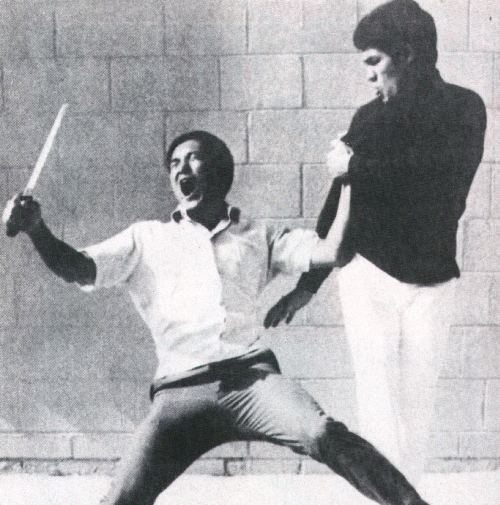
‘Bruce Lee’s Fighting Method’ is an extremely practical book about street combat. Such books are rare, very rare, since unfortunately bad and impractical books on self defence are not.
The book was compiled by Lee in co-operation with his good friend Mr Uyehara of Ohara Publications. The techniques used in the street fighting sequences mirror the very basic concepts outlined in the ‘Tao of Jeet Kune Do’.
The situations Lee meets as the victim are typical of the mugging approaches to be found both in the United States and the United Kingdom. Lee’s response to these ugly situations combines facets of responsibility, effectiveness and the dynamism that was Lee, and are the hallmarks of great self defence.
Note well, Lee fans, very little of Lee’s “Movie techniques” are to be found in its pages. This slim, dynamic little manual is practically devoid of kicks that are any higher than waist level, not one single flying kick or acrobatic leap is to be seen.
The emphasis rather is on evasion, body turning, striking and immobilisation in that order. These movements conform with every iota of the theory behind the combat system found in Jeet Kune Do.
The photography used In the Fighting Method is especially good, it is to be commended for its clear, sharp definition and good contrast; there is excellent use of angle shots and background scenery giving to an over all first class picture composition.
The guy behind the Ohara camera certainly knew his job. Lee undoubtedly worked closely with the photographic production of this book as he was very skilled in the art of camera technique, a little something he had picked up whilst working on studio lots from the age of eleven.
The basic message of the book is that Jeet Kune Do makes for great self protection, a thing that urban societies under seige of the seventies has gone crazy on.
In this book we can see that Bruce Lee was familiar with the workings and techniques of many of the world’s martial arts. It is common knowledge that Lee had a cursory but firm understanding of Judo, Karate, Aikido and Jiu Jitsu, which he obtained by training with friends he had in the martial arts community.
A lesser known fact, revealed after his death by his wife Linda is that Bruce had one of the finest collections of martial arts, physical culture and sports books, perhaps the finest martial arts library outside of the orient. Intense study and strenuous research enabled Lee to formulate his understanding of martial arts, which he synthesises in Jeet Kune Do.
Jeet Kune Do though based very roughly along the lines of classical Ch’uan Fa, takes in the techniques of nearly ever every martial art, Western and Eastern from Savate to Penjat Silat. The theory of combat and its application; that is the motivation behind Jeet Kune Do; was formulated by Lee over a period of time and bears witness to Lee’s combat experience and maturity in the martial arts if nothing else.
In street combat, Lee was more than a mere innovator, he was if ‘Fighting Method’ is to be accepted for what it is, a martial genius.
The name Bruce Lee brings a mixed reaction from martial artists of every shade of opinion and teaching. By the more conservative he is regarded as an upstart who debased what little knowledge they believed him to have had.
The more radical elements look upon him as perhaps the greatest innovator in the 3000 years of formalised martial arts history. A great saviour who synthesised all that was useful and could be found in that which is called the martial arts. To them, he is amidst the ranks of Funakoshi – Kano – Ueshiba – Miyamoto, and Lee’s own teacher Yip Man.
To date the only material on which any martial artist could base his judgement of Lee and Lee’s contribution to the world of martial arts, was Lee’s films which hit the Western world in 1971 with all the power of one of his famous ‘one inch’ punches.
It is a pity that Lee died before the martial arts world could read and appreciate his published work.
His death is to be doubly regretted for undoubtedly, it would have meant that that martial artists everywhere would have had to reassess their opinions of Lee and his ability – the radical as well as the conservative.
